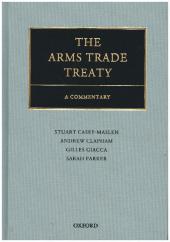 Neuerscheinungen 2016Stand: 2020-02-01 |
Schnellsuche
ISBN/Stichwort/Autor
|
HerderstraŖe 10
10625 Berlin
Tel.: 030 315 714 16
Fax 030 315 714 14
info@buchspektrum.de |

Stuart Casey-Maslen, Andrew Clapham, Gilles Giacca, Stuart Casey- Maslen
(Beteiligte)
The Arms Trade Treaty
A Commentary
2016. 544 S. 253 mm
Verlag/Jahr: OXFORD UNIVERSITY PRESS; OUP OXFORD 2016
ISBN: 0-19-872352-0 (0198723520)
Neue ISBN: 978-0-19-872352-3 (9780198723523)
Preis und Lieferzeit: Bitte klicken
The Arms Trade Treaty is the first universal disarmament treaty to control the export and import of all conventional arms. This commentary describes each provision of the Treaty, how it was negotiated, and the key challenges to its implementation.
The United Nations Arms Trade Treaty became binding international law in late 2014, and although the text of the treaty is a relatively concise framework for assessing whether to authorize or deny proposed conventional weapons transfers by States Parties, there exists controversy as to the meaning of certain key provisions. Furthermore, the treaty requires a national regulatory body to authorize proposed transfers of conventional weapons covered by the treaty, butdoes not detail how such a body should be established and how it should effectively function. The Arms Trade Treaty: A Commentary explains in detail each of the treaty provisions, the parameters for prohibitions or the denial of transfers, international cooperation and assistance, and implementationobligations and mechanisms. As states ratify and implement the Treaty over the next few years, the commentary provides invaluable guidance to government officials, commentators, and scholars on the meaning of its contentious provisions. This volume describes in detail which weapons are covered by the treaty and explains the different forms of transfer that the Arms Trade Treaty regulates. It covers international human rights, trade, disarmament, humanitarian law, criminal law, andstate-to-state use of force, as well as the application of the treaty to non-state actors.
The commentary constitutes a meticulous and well-structured study of the ATT that will be highly useful not only to academics but also to practitioners working on the subject of arms transfers. Above all, it sheds light on a number of vague terms and potential loopholes in the ATT by reference to the treaty‚s drafting process, its object and purpose, States parties‚ other relevant obligations under international law and their initial views on how the treaty should be interpreted. Marlitt Brandes LL.M., German Yearbook of International Law


